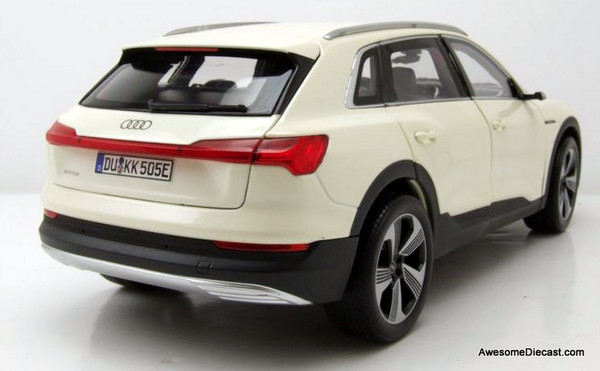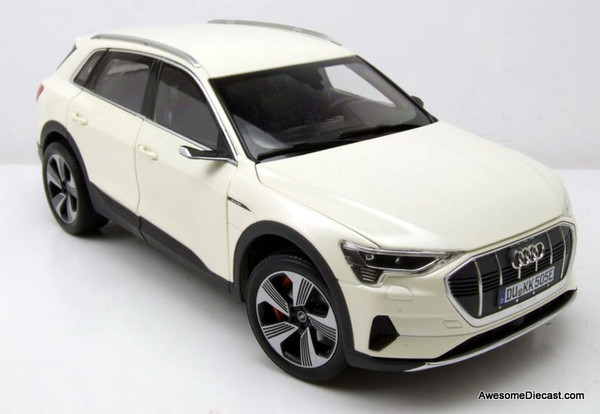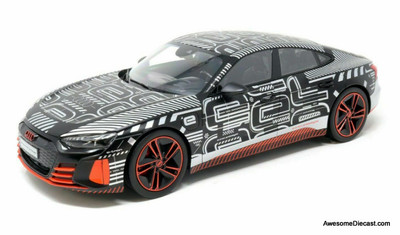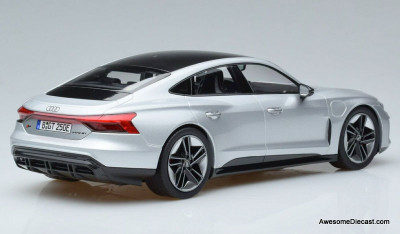The Audi e-tron is a fully-electric mid-size luxury crossover SUV produced by Audi, which was unveiled as a concept car at the 2015 Frankfurt Motor Show. It is the company's first electric mass production car, and was first delivered in May 2019. It has an EPA range of 204 miles (328 km).
The Audi e-tron is based on the e-tron quattro concept that was unveiled at the 2015 Frankfurt Motor Show. The final production version was revealed in San Francisco on 17 September 2018, and it publicly debuted at the 2018 Paris Motor Show.
Scheduled for deliveries in Europe by December 2018, it got delayed to 2019 (customers reported expected delivery dates close to the end of 2019 - see the paragraph below); the car's certification in Germany by the KBA (Federal Motor Transport Authority) was not obtained until required changes were made to the car's software. In January of 2019, US market deliveries were due to commence in June.
Though in March 2019 the first customer in Germany received his e-tron, in late April 2019 it was reported that prospective customers faced waiting lists of 6–7 months (putting the expected delivery date close to the end of 2019). The delays caused controversy in Norway, where customers were informed that their cars would be delivered up to 6 months later than originally promised unless they paid extra for a significantly more expensive "Fast Track" car. Further to this, some customers were also informed that were they to cancel their reservation they would be liable for a fine equal to 8% of the purchase price.
Both in Germany and in the US, hundreds of e-trons were registered before the first publicized delivery to a customer in the respective area occurred, which suggests they performed the role of test vehicles of some sort. In June 2019 Audi of America claimed there are 1,644 e-trons in the US and 540 of these are in the hands of customers.
During the first three quarters of 2019, there were 3,540 registrations of the e-tron in the USA, 3,824 in Norway, 2,997 in Germany and 706 in the Netherlands.
In October 2019, the e-tron was the best-selling car or truck of any kind in Norway. In November 2019, it ranked #3.
The Audi e-tron is powered by a 95 kWh battery pack of which 83.6 kWh is usable. It is able to get an 80% charge in around 30 minutes when using 150 kW DC fast-chargers. For at-home charging, there is a standard 11 kW charger which charges it in 8.5 hours, while an optional 22 kW charger halves this time. A liquid cooling system (also serving the motors and power electronics) keeps the battery between 23-35 degrees Celsius, and battery modules (twelve 60 Ah cells each) can be replaced.
The quattro electric all-wheel drive uses two electric motors, one mounted to the front and one at the rear. An early specification rated these two motors at a total system output of 300 kW (408 PS; 402 hp) and 664 N⋅m (490 lb⋅ft) of torque enabling the car to accelerate from 0–100 km/h (0–62 mph) in 5.7 seconds and on to a top speed of 200 km/h (120 mph) . The actual production version has a combined peak motor power of 265 kW (360 PS; 355 hp), with 125 kW (170 PS; 168 hp) from the front motor at a torque of 247 N⋅m (182 lb⋅ft) and 140 kW (190 PS; 188 hp) from the rear motor at a torque of 314 N⋅m (232 lb⋅ft). This allows the car to accelerate from 0–100 km/h (0-62 mph) in 6.6 seconds and on to its top speed of 200 km/h (124 mph).
The car uses an energy recuperation system which, on average, contributes 30% to the range. Recuperation can be achieved both when the driver releases the accelerator and when applying pressure to the brake.
When the car is equipped with the virtual side mirrors the car has a drag coefficient of 0.27. The e-tron also sits slightly lower than a traditional SUV; at 1,616 mm (63.6 in) high, it is 43 mm (1.7 in) lower than the Audi Q5. It has 660 litres (23 cu ft) of boot space, 160 l (5.7 cu ft) more than the Mercedes-Benz EQC, along with 60 litres (2.1 cu ft) of storage space in the front.
























